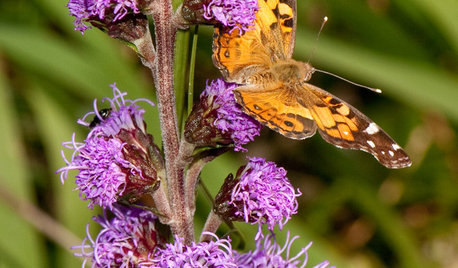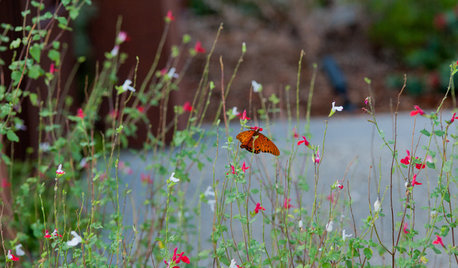Needing Monarch Butterfly Migration Sightings
linda_centralokzn6
14 years ago
Featured Answer
Sort by:Oldest
Comments (50)
spademilllane
14 years agolast modified: 9 years agoOkiedawn OK Zone 7
14 years agolast modified: 9 years agoRelated Discussions
Monarch Migration Program On PBS's Nova
Comments (3)I agree Butterflutter! It was posted to the Texas Garden Forum also as well as sent to many on my email address list. Maybe someone announced it here already. I've been out of town and haven't read all the more recent posts, but did look for a title announcing the program before posting. Sorry if it's a repeat....See MoreRequest for Monarch Butterfly Sightings
Comments (6)I just registered with the site, even got a password. It's lot letting me use the site map. I don't have dates, but I've been seeing the monarch for at least 2 weeks. I did have monarch eggs early this spring around May. Never saw the adults, but had baby cats. I think these were migrating north. I should be seeing some baby cats soon. I have lots of wasp in my garden, so I will need to bring some into my sunroom and raise them....See MoreMonarch Butterflies - Fall Migration
Comments (10)Those are beautiful Annie.I've been seeing more of them around here as well,usually on the butterfly bush and the dahlias. There was a smaller BF on one of my potted impatients on friday,don't know what kind it was,but it let me water the plant and didn't even fly off.Of course i steered clear of where he/she was feeding, Talked to my sister in Washingtonville N.Y. yesterday and she told me when she went out in her yard saturday,the deer had made an overnight visit and ate all her plants,and some of the deer were still up on the hill eating from the apple tree.She was very upset,as i would have been as well. Kathi...See MoreMonarch Butterfly migration
Comments (10)Our plants are so messed up. We still have white autumn asters (the little native ones) in bloom for the butterflies, but most other autumn wildflowers seem like they are finishing up, so the monarchs need to hurry up and get headed south. The last day or two, I've seen several new, freshly emerged monarchs hanging onto plants, wings stretched out---like they are drying their wings before they fly. Since the fall wildflowers are finishing up (goldenrod and liatris are done, white asters and some of the blue autumn sage still are blooming in the fields, and some of the helenium too), I think the butterflies cannot delay heading south too much longer. However, we have some spring bloomers, largely red Indian paintbrush and the pink Spring Beauties, and some tiny frogfruit flowers too, that have emerged and are blooming. I assume that they went dormant in the hot, dry summer weather as always and then, when all that heavy rain fell at the end of August, they reacted as if it were spring, and sprouted, grew and are blooming now. It is odd, but not unheard of after a very dry summer. The various types of butterflies that hang around the garden still have morning glories, four o'clocks, daturas, moonvine flowers, periwinkles, zinnias and more in bloom, but the monarchs that are traveling are going to be finding less and less in the fields at this late date. Normally the monarchs all have cleared our area by now, but I've seen some every day this week so they're obviously lagging behind. If yours left a couple of days ago, then ours should clear the area here soon. We've been pretty warm during the day, but some of the nights have been in the 40s at our house and in the 30s at our Mesonet station at Burneyville. I'm not sure what their cold tolerance is, but surely they know they need to be getting further south than here by this late in October....See Morelinda_centralokzn6
14 years agolast modified: 9 years agoOkiedawn OK Zone 7
14 years agolast modified: 9 years agoelkwc
14 years agolast modified: 9 years agolinda_centralokzn6
14 years agolast modified: 9 years agoelkwc
14 years agolast modified: 9 years agoOkiedawn OK Zone 7
14 years agolast modified: 9 years agolinda_centralokzn6
14 years agolast modified: 9 years agoOkiedawn OK Zone 7
14 years agolast modified: 9 years agoelkwc
14 years agolast modified: 9 years agolinda_centralokzn6
14 years agolast modified: 9 years agopanhandlejan
14 years agolast modified: 9 years agolinda_centralokzn6
14 years agolast modified: 9 years agomulberryknob
14 years agolast modified: 9 years agolinda_centralokzn6
14 years agolast modified: 9 years agoOkiedawn OK Zone 7
14 years agolast modified: 9 years agoNancy Fryhover
14 years agolast modified: 9 years agolinda_centralokzn6
14 years agolast modified: 9 years agokathi_rogers
14 years agolast modified: 9 years agokathi_rogers
14 years agolast modified: 9 years agolinda_centralokzn6
14 years agolast modified: 9 years agoOkiedawn OK Zone 7
14 years agolast modified: 9 years agorosa43
14 years agolast modified: 9 years agoNancy Fryhover
14 years agolast modified: 9 years agorosa43
14 years agolast modified: 9 years agolinda_centralokzn6
14 years agolast modified: 9 years agorosa43
14 years agolast modified: 9 years agoOkiedawn OK Zone 7
14 years agolast modified: 9 years agospademilllane
14 years agolast modified: 9 years agoNancy Fryhover
14 years agolast modified: 9 years agolinda_centralokzn6
14 years agolast modified: 9 years agogamebird
14 years agolast modified: 9 years agoOkiedawn OK Zone 7
14 years agolast modified: 9 years agospademilllane
14 years agolast modified: 9 years agothat_owl
14 years agolast modified: 9 years agothat_owl
14 years agolast modified: 9 years agolinda_centralokzn6
14 years agolast modified: 9 years agothat_owl
14 years agolast modified: 9 years agoksokiegonnab
14 years agolast modified: 9 years agogamebird
14 years agolast modified: 9 years agobettycbowen
14 years agolast modified: 9 years agolinda_centralokzn6
14 years agolast modified: 9 years agogamebird
14 years agolast modified: 9 years agorosa43
14 years agolast modified: 9 years agojerry8463
8 years agomadabttomatoes
8 years agoHarriett Wahler
8 years agojmichigan
8 years ago
Related Stories

GARDENING FOR BUTTERFLIESBe a Butterfly Savior — Garden for the Monarchs
Keep hope, beauty and kindness alive in the landscape by providing a refuge for these threatened enchanters
Full Story
CALIFORNIA NATIVE PLANTSGreat Design Plant: Asclepias Is Attractive to Monarch Butterflies
Increase monarch butterfly populations in California by planting stunning native milkweeds
Full Story
GARDENING GUIDESGreat Design Plant: Asclepias Incarnata for a Butterfly Garden
Beautiful swamp milkweed makes it easy to help monarchs and other pollinators in eastern U.S. gardens
Full Story
GARDENING GUIDESAmerican Lady Butterflies Add Delight to Summer Gardens
Provide native nectar and larval host plants to welcome these migratory butterflies
Full Story
GARDENING GUIDES6 Steps to Creating Your Butterfly Garden
Encourage these fanciful winged beauties to visit your garden while helping restore their fragmented habitat
Full Story
GARDENING GUIDES6 Plants That Beat Butterfly Bush for the Wildlife Draw
It's invasive, a nonnative and a poor insect magnet. Check out these better alternatives to butterfly bush in the garden
Full Story
GARDENING GUIDES20 Favorite Flowers for Butterflies and Bouquets
Discover perennials and annuals that do double duty as butterfly magnets and versatile cut flowers
Full Story
GARDENING FOR BUTTERFLIESButterfly Gardening: Delight the Eyes With Living Sculptures
Surprise and thrill with a garden that attracts magical winged creatures, bringing color, movement and life
Full Story
EARTH DAYCreate a Container Wildlife Habitat for Hummingbirds and Butterflies
Don’t let limited space prevent you from welcoming wildlife into your garden
Full Story
GARDENING GUIDESGreat Design Plant: Milkweed
Quit cringing. This not-weed plant is a sight to behold in the garden, has a delicious vanilla scent and is a magnet for butterflies
Full Story



nowyousedum